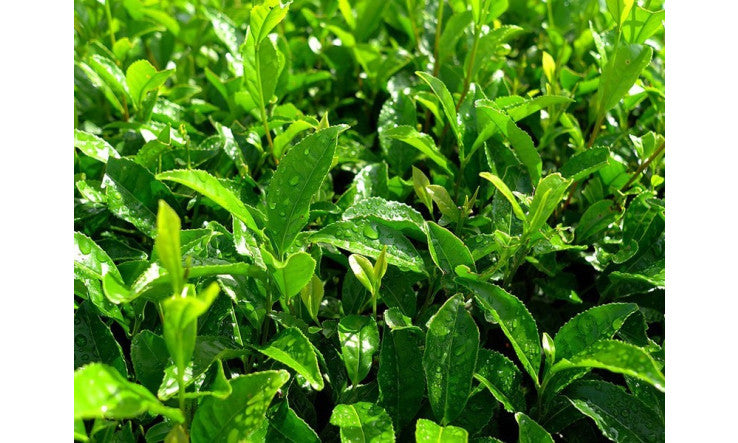Green tea and its many benefits
Consumed around the world, tea has enormous potential for health benefits, including reducing the risk of developing certain diseases, as research has shown. Among its many benefits, it is worth mentioning:
- Green tea is said to promote long-term weight loss through its 3 combined actions: 1- Increased basal metabolic rate. 2- Improved glucose absorption by muscles. 3- Increased fat burning in the liver and muscles. 1 Dr. Willem suggests green tea as an aid in treating cellulite, as it is known to eliminate excess water and fat. 2
- Tea and its catechins have also been shown to have positive effects on type 2 diabetes. 3
- Green tea contains polyphenols called catechins. These molecules are absorbed and bind directly to tissues, protecting them. 4 In the skin and dermis, they reduce free radical damage and prevent the formation of cross-links. These cross-links are a consequence of aging but also of the sun's action. We refer to these as actinic damage (due to the sun). Their appearance in the collagen of the dermis leads to a loss of suppleness and an acceleration of wrinkle formation. Catechins reduce their formation, accelerate their degradation, and protect against agents that increase their formation, such as excessive and chronic UV rays. Regular consumption of green tea protects against sunburn and UV damage. 5 To learn more about green tea and skin protection, click here !
- Flavanoids (polyphenols) are also found in tea. Their antioxidant action has been known for a very long time. The most active catechin in green tea (called epigallocatechin gallate) also has exceptional antioxidant activity, 200 times higher than vitamin E. 5
- In addition, a clinical study found that a drink high in catechins consumed for 12 weeks visibly and measurably improved skin structure. There was an improvement in elasticity, roughness, desquamation, dermal density and hydration. 6
- Consuming tea rich in catechins could also help normalize sebum and therefore be useful both for skin health (hydration) but also for the prevention and treatment of acne. 7
- Green tea may even slow down skin aging. 8
- Green tea may also have many antihypertensive benefits, improving cholesterol levels, insulin resistance, and inflammation. 9
- Mood, sleep, stress: Green tea naturally contains L-theanine. L-theanine can affect the levels of certain chemicals in the brain. These include serotonin and dopamine, which influence mood, sleep, and emotions, and cortisol, which helps the body manage stress. 10
- Oral Health: Studies show that green tea also promotes periodontal health by reducing inflammation, preventing bone resorption, and limiting the growth of certain bacteria associated with periodontal disease. 11,12,13
- A more recent study (2017) examined the effects of a specific polyphenol from green tea (epigallocatechin gallate); this polyphenol can significantly inhibit the formation and growth of S. mutans biofilm (bacteria that cause caries) on the surface of dentin. 14
References:
1. Thielecke F, Boschmann M. The potential role of green tea catechins in the prevention of the metabolic syndrome - a review. Phytochemistry. 2009 Jan;70(1):11-24. doi: 10.1016/j.phytochem.2008.11.011. Epub 2009 Jan 13. PMID: 19147161.
2. Jean-Pierre Willem. I Want to Be a Young Centenarian: The Essentials for Taking Care of Yourself and Staying Healthy. Éditions Dudauphin, October 10, 2013. ISBN: 9782716314930
3. Iso H, Date C, Wakai K, Fukui M, Tamakoshi A; JACC Study Group. The relationship between green tea and total caffeine intake and risk for self-reported type 2 diabetes among Japanese adults. Ann Intern Med. 2006 Apr 18;144(8):554-62. doi:10.7326/0003-4819-144-8-200604180-00005. PMID: 16618952.
4. OyetakinWhite P, Tribout H, Baron E. Protective mechanisms of green tea polyphenols in skin. Oxid Med Cell Longev. 2012; 2012:560682. doi:10.1155/2012/560682. Epub 2012 Jun 26. PMID: 22792414; PMCID: PMC3390139.
5. Rhodes LE, Darby G, Massey KA, et al. Oral green tea catechin metabolites are incorporated into human skin and protect against UV radiation-induced cutaneous inflammation in association with reduced production of pro-inflammatory eicosanoid 12-hydroxyeicosatetraenoic acid. Br J Nutr. 2013 Sep 14;110(5):891-900. doi: 10.1017/S0007114512006071. PubMed PMID: 23351338. https://www.ncbi.nlm.nih.gov/pubmed/23351338
6. Heinrich U, Moore CE, De Spirt S, et al. Green tea polyphenols provide photoprotection, increase microcirculation, and modulate skin properties of women. J Nutr. 2011 Jun;141(6):1202-8. doi:10.3945/jn.110.136465. PubMed PMID: 21525260. https://jn.nutrition.org/content/141/6/1202.long
7. Saric S, Notay M, Sivamani RK. Green Tea and Other Tea Polyphenols: Effects on Sebum Production and Acne Vulgaris. Antioxidants (Basel). 2016 Dec 29;6(1):2. doi:10.3390/antiox6010002. PMID: 28036057; PMCID: PMC5384166. https://www.mdpi.com/2076-3921/6/1/2
8. Li YH, Wu Y, Wei HC, et al. Protective effects of green tea extracts on photoaging and photommunosuppression. Skin Res Technol. 2009 Aug;15(3):338-45. doi: 10.1111/j.1600-0846.2009.00370. x. PubMed PMID: 19624431. https://www.ncbi.nlm.nih.gov/pubmed/19624431
9. Bogdanski P, Suliburska J, Szulinska M, Stepien M, Pupek-Musialik D, Jablecka A. Green tea extract reduces blood pressure, inflammatory biomarkers, and oxidative stress and improves parameters associated with insulin resistance in obese, hypertensive patients. Nutr Res. 2012 Jun;32(6):421-7. doi: 10.1016/j.nutres.2012.05.007. Epub 2012 Jun 20. PMID: 22749178.
10. Jackson Williams, Jane Kellett, Paul Daniel Roach, Andrew McKune, Duane Mellor, Jackson Thomas, Nenad Naumovski. L-Theanine as a Functional Food Additive: Its Role in Disease Prevention and Health Promotion. Beverages 2016, 2(2), 13; https://doi.org/10.3390/beverages2020013
11. Chatterjee A, Saluja M, Agarwal G, Alam M. Green tea: A boon for periodontal and general health. J Indian Soc Periodontol. 2012 Apr;16(2):161-7. doi:10.4103/0972-124X.99256. PMID: 23055579; PMCID: PMC3459493.
12. Mitoshi Kushiyama, Yoshihiro Shimazaki, Masatoshi Murakami, Yoshihisa Yamashita. Relationship Between Intake of Green Tea and Periodontal Disease. Clinical Science. First published: 01 March 2009. https://doi.org/10.1902/jop.2009.080510
13. Sakanaka S, Aizawa M, Kim M, Yamamoto T. Inhibitory effects of green tea polyphenols on growth and cellular adhesion of an oral bacterium, Porphyromonas gingivalis. Biosci Biotechnol Biochem. 1996 May;60(5):745-9. doi:10.1271/bbb.60.745. PMID: 8704303
14. Jian Yu, Hongye Yang, Kang Li, Hongyu Ren, Jinmei Lei and Cui Huang. Development of Epigallocatechin-3-gallate-Encapsulated Nanohydroxyapatite/Mesoporous Silica for Therapeutic Management of Dentin Surface. ACS Appl. Mater. Interfaces 2017, 9, 31, 25796–25807. Publication Date: July 13, 2017. https://doi.org/10.1021/acsami.7b06597 Copyright © 2017 American Chemical Society
Maison Jacynthe disclaims all liability. All information contained on this page is not intended to replace justified allopathic treatment or to disregard the expertise of the medical profession. It is up to each individual to take charge of their own health, to inform themselves, and to make the necessary changes to improve their condition. Therapeutic supervision by a qualified health professional is obviously recommended.


































































Leave a comment